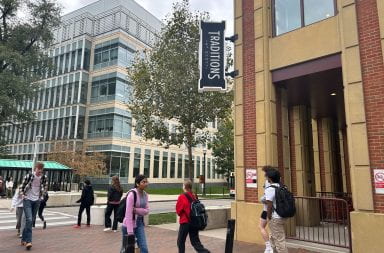
Ohio State Dining Services revamped their grab-and-go options available at cafes around campus and added more locally-sourced items to its dining hall menus. Credit: Ris Twigg | Assistant Photo Editor
With time comes change, and Ohio State dining services is bringing big changes to campus food and meal plans this fall.
Among the changes are new menu additions in several dining locations. Oxley’s-to-go –– located next to Oxley’s by the Numbers –– offers a new sandwich concept that includes more locally sourced food and the ability for students with a Traditions plan to use the to-go option.
“We typically make adjustments like every other menu,” said Zia Ahmed, senior director of dining services. “We made some adjustments based on feedback, but this year we felt like it’s been a couple of years that we haven’t had a major revamp of the menu.”
The biggest changes to the menu have been made to the grab-and-go options available in cafes and market locations across campus.
Some of the new grab-and-go items available to students are Japanese-inspired bento boxes, which are single-portion containers which traditionally hold rice, fish or meat and cooked vegetables. Also featured is a custard-like Greek yogurt panna cotta and several new salad options like spicy chicken and cobb.
“Our entire grab-and-go package we’ve revamped and made it a lot more brighter, colorful.” Ahmed said. “They were great before but we’ve made it even better by bringing in more color, more vegetables [and] more fresh items.”
Another big dining modification applies to the unlimited meal plan. Students with this plan will now be able to take Traditions meals to-go once per meal time, up to five times a week.
Ahmed said the change to the to-go option was based entirely off student feedback.
“The majority of our ideas, if not all of them, come from student feedback,” he said. “Based on the feedback we received a significant interest from students who were using unlimited plans to have the to-go option available to them.”
Ahmed said he worked with Undergraduate Student Government to gauge what changes students want to bring to dining services. He and USG found that students with the unlimited plan pushed for the to-go option.
Shamina Merchant, a third-year in business administration and the USG deputy chief of staff, said USG collected data on student feedback last year and looked at dining options at other universities to help dining services develop the to-go program for unlimited plans.
“[Ahmed] was very receptive to the idea. I think this was a concern he was hearing as well,” she said. “Together with the student data we were able to put together, as well as the benchmarking from other universities, Zia and the dining team went ahead and implemented this program.”
As part of the university’s goal to have 40 percent of food on campus locally and sustainably procured by 2025, Oxley’s-to-Go’s sandwich station will use mostly locally sourced, sustainable ingredients.
“We’re testing a lot of local meat and cheeses at this sandwich shop, so not only you’re going to have a great sub sandwich, but many of the ingredients that we’re going to be serving are locally sourced,” Ahmed said. “This will be also a great experiment for us to see in the future how to expand the locally sourced products.”
Another stride dining services has made toward including more locally sourced food on campus is making one of the most popular items on its Traditions menu –– a chicken nugget found at Scott Traditions –– locally sourced and manufactured, Zia said.
Some other major menu updates have also made their way to the Traditions and market locations, including a Pho fusion noodle station at Scott Traditions, spiralized vegetable noodles at all of the pasta stations across campus and a Mexican-Brazilian fusion taco station at the Union Marketplace. The pizza station in Neil Marketplace will now be a build-your-own style rather than menu-based as well.
For Ahmed, bringing in a variety of foods from around the world is how dining services is able to not only feed Ohio State students, but teach them as well.
“Every dining interaction is an educational opportunity for our students, and we take that very seriously,” he said. “So we’re just not serving food but we’re telling them a story, we’re hoping to teach them a few things about the food system, about the different type of cuisine.”


